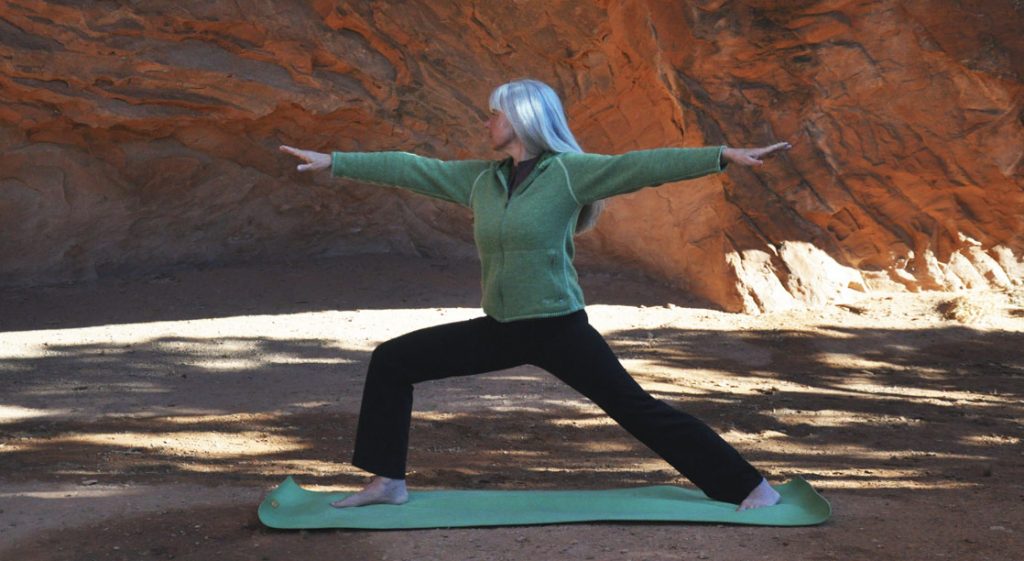Healthy SI Joint: Part 3
The last few weeks, I’ve shared posts on this blog about the sacroiliac (SI) joint, a part of human—particularly female—anatomy that tends toward injury in yoga practice. This post introduces the joint, and this one explains how to work with one of the problematic alignment cues that can contribute to SI joint dysfunction.
Today’s post will address one of yoga’s most persistent, and potentially damaging, alignment cues: squaring the hips. I first heard this instruction in the 1980s, in numerous Iyengar-based classes and workshops. Back then, squaring the hips in asymmetrical standing poses such as Trikonasana (Triangle Pose) was thought to be healthy alignment.
But the fact is, it’s unlikely that anyone’s hip joints are designed to do this. When you try to square the hips in asymmetrical standing poses, something has to give. That “something” could be the knee and/or the hip joint of the front leg. And then there’s the SI joint. When you try to square the hips in standing poses, one side of the SI joint jams together and the other stretches open. This puts asymmetrical force on the joint that can destabilize it over time. (Remember that for the SI joint to function properly, it has to be stable.)
How Not to Square the Hips in Standing Poses
Because every person’s hip joints are different, there’s no one-size-fits-all cue for the perfect pelvic angle. In the same way that untucking the tailbone looks different for different people, the rotation of the pelvis will look different for different people. So you have to develop internal cues.
Warrior II is the pose where I discovered the importance of rotating my pelvis. For many years I hated the pose because my front leg would quickly get fatigued and become shaky and unstable. This is because all my weight was dumping onto the front leg. While on a 30-day silent meditation retreat in the ’90s, I began experimenting with my pelvic position while in Warrior II. When I allowed my pelvis to rotate inward, suddenly my back leg clicked in and began to give support. Then my front leg no longer had to do all the work. I found that I could hang out in Warrior II for minutes at a time and not feel tired. It was a revelation. From then on, I’ve practiced all standing poses this way. Not only has it made my standing poses much stronger, but it has also helped alleviate chronic SI joint pain.
An SI Joint-Friendly (Warrior II)
Here’s how I instruct finding the optimal pelvic rotation. I’ll use Virabhadrasana II (Warrior II Pose) as an example.
Stand on a nonskid yoga mat with your feet wide apart—2 to 3 feet—and parallel. Place your hands on your pelvic rim.
Turn your entire right leg—your foot, shin, knee and thigh—outward 90 degrees, so that your foot is pointing toward the end of your mat.
Turn your entire left leg—your foot, shin, knee and thigh—inward about 30 degrees. Feel how your back foot is grounding.
Actively try to ground your back foot. Now slowly rotate the left side of your pelvis inward, until you feel the back foot rooting more firmly into your mat. This is likely to be your optimal pelvic rotation.
Another inner reference that works for some people is to rotate the pelvis until they feel both heels aligning with their respective ischial tuberosities (sit bones).
Extend your arms outward from your shoulders so that they are parallel to the floor.
Now ground your back foot as you bend your front knee, tracking it out over your front foot. If your pelvis is in its optimal rotation, you will feel your weight evenly distributed between the right and left feet. If your pelvis is not in its optimal rotation, you will likely feel most of your weight on your front foot. Feel free to explore your pelvic rotation while you’re in Warrior II to find the rotation that allows your feet to easily support your weight evenly.
Take 5 to 10 deep breaths in the pose.
Ground your left foot and push with your right to straighten your knee. Turn your feet to parallel and rest for a few breaths.
Move to the other side.
If you’re interested in learning more about your hips and SI joint, check out my most recent book, Hip-Healthy Asana: The Yoga Practitioner’s Guide to Protecting the Hips and Avoiding SI Joint Pain.
Leave a Reply Cancel reply
Recent Comments
Archives
- December 2025
- November 2025
- October 2025
- September 2025
- August 2025
- July 2025
- June 2025
- May 2025
- April 2025
- March 2025
- February 2025
- January 2025
- December 2024
- November 2024
- October 2024
- September 2024
- August 2024
- July 2024
- June 2024
- May 2024
- April 2024
- March 2024
- February 2024
- January 2024
- December 2023
- November 2023
- October 2023
- September 2023
- August 2023
- July 2023
- May 2023
- March 2023
- August 2022
- July 2022
- June 2022
- May 2022
- April 2022
- March 2022
- February 2022
- January 2022
- December 2021
- November 2021
- October 2021
- September 2021
- August 2021
- July 2021
- June 2021
- May 2021
- April 2021
- March 2021
- February 2020
- January 2020
Theme by The WP Club . Proudly powered by WordPress
